Our exhibition for the Gail Harker Center for Creative Arts for Level 3 Advanced Experimental Stitch is now complete. I say this with a sigh of relief twinged with a bit of sadness. We’ve been in this course for the last 2 1/2 years… meeting every three months and working on homework just about daily during that time. My friends in the class and I have grown artistically through the process that our mentors, Gail Harker and Penny Peters, have instilled as a way of working, applying design and testing to our artwork.

Graduates (L to R) Marilyn Olsen, Christina Fairley Erickson, Nancy Drake, Tutors Penny Peters and Gail Harker, and graduate Barbara Fox
As part of the exhibition, each of the graduates had to give a talk and answer questions on some aspect of their studies or artwork. I spent the majority of my time explaining my process for making my large-scale Stumpwork (or 3D embroidery) heron.

Christina describes how her 3D Stumpwork embroidery process includes making a painting of the design.

Christina shares her sketchbook of samples for making the 3D heron.
A second assessment piece was a 3D project (the wall piece wasn’t required to be 3D, I decided to stretch my artistic abilities and make it Stumpwork). My vessel based on a wave went through numerous renditions. Perfecting the shape through making models from paper, then from the heavy duty interfacing that stiffens the vessel took much more time than one would imagine. Not to mention all the hours of beading and hand stitching!
We also had two historical projects for the class. One focused on Native American stitchwork and the other on a study of Stitchwork brought to the US from European immigrants. We made artwork based on pieces we found in our research, including some stitched samples.

Some spreads from Christina’s Native American Stitch Study

Christina’s sample based on a Haida Eagle button blanket
I’m so appreciative of our tutors/mentors Gail and Penny, who led us on this journey. As I have witnessed from their other class exhibitions, each of us as students were given the same guidelines but have developed our artwork into something uniquely our own. I look forward to continuing on in class at the next level, when it’s offered… but I also look forward to catching my breathe after such a big push to put on an exhibition of this magnitude! Here are some more photos of my work at the show (wish I could fit it all in!):

Dark & Moody contemporary hand and freehand machine embroidery

“It’s NOT the Real Thing” – darned Pepsi cup and Christina’s sketchbook design for it worried everyone that someone had left a drink on the table with artwork!

“Crested Serpent Eagle” and “Cheeky Blue Heron”

“Feelin’ Good Triptych” by Christina Fairley Erickson was based on listening the the song “Feelin’ Good” by Michael Buble
Last night I attended the preview party for the 2018 Quilt and Fiber Art Festival in Everett, WA. With all the wonderful entries in this large International show, I’m awestruck and so humbly honored… I won 4 awards!
A Best of Show-Mixed Techniques Award Of Excellence for the show, “In Klimt’s Corral”
3rd place for Fiber Art- Mixed Media, “In Klimt’s Corral”
2nd place for Fiber Art- 3D/Sculptural, “Bullkelp Vessel”
2nd place for Fiber Art- Needlework, “Crested Serpent Eagle”
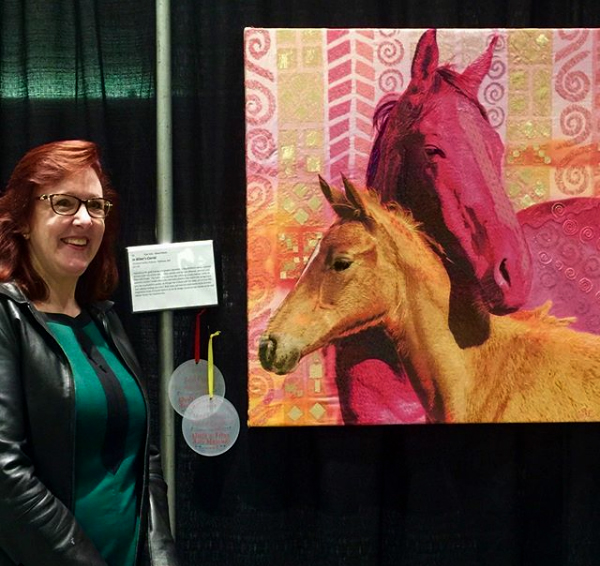
 “In Klimt’s Corral” will be included in the “Award Winners: Quilt and Fiber Arts Festival 2018” exhibit at the Pacific Northwest Quilt & Fiber Art Museum from October 17 – November 18, 2018.
“In Klimt’s Corral” will be included in the “Award Winners: Quilt and Fiber Arts Festival 2018” exhibit at the Pacific Northwest Quilt & Fiber Art Museum from October 17 – November 18, 2018.
Meanwhile, I’ll be scooping up the Bullkelp Vessel and Crested Serpent Eagle pieces to include in my exhibition later this month at the La Conner Country Inn. I’m still working feverishly to finish up all my pieces for that exhibit. I haven’t even taken time to count them all up, but I think I have about 30 pieces. I’ve continued to work many of my pieces to my theme of “the Water’s Edge”, coinciding with all the work I did on seaweeds during my 2 year Level 3 Art & Design class.

“Bull Kelp Forest Vessel” – 2nd place Fiber Art 3D / Sculptural by Christina Fairley Erickson
I want to thank my family for all the support they’ve given me as I continue on my fiber artist journey. I was so happy have my Mom, husband Randy, and daughter-in-law Zeyneb with me at the preview party last night, and I look forward to our other kids coming to my Advanced Stitch Exhibition. I have to give extra acknowledgement to Randy for putting up with my constant stitching or other work while we spend time together as well as having my art supplies stretching into all corners of our house! I appreciate all the support from both family and friends.

Mom Nan Cerini-Lopis and husband Randy Erickson at the Preview Party – 2018 Quilt & Fiber Art Festival

Christina with her “Crested Serpent Eagle” -2nd Place for Fiber Arts-Needlework and her piece “Fern Frond”
As many of you know, I have been studying at the Gail Harker Center for Creative Arts for some time… I believe it’s 8 years now. I’m just finishing 2 1/2 years in the Level 3 Advanced Experimental Stitch course. Our class will be exhibiting coursework including assessment items, sketchbooks, presentation books, samples, and historical stitch studies at an exhibition on October 26-27.

Mark your calendars! We will also have an artist talk from 10:30-11:30 am on Saturday October 27.
UK Tour Day 3- Horniman Museum & Gardens

Karen Dodd’s “Coral:Fabric of the Reef” installation
When I plan my trips, every once in a while I throw in a ‘ringer’ – some place I may have heard obscure reference to, I’m unsure about what I’ll find and decide to try our just for kicks. It’s also good to plan some things which might really appeal to my husband Randy, who’s sweet and tolerent enough to accompany me on my textile exploits.
I read the description of the Horniman Museum and Gardens as a “quirky Victorian collection of artifacts” and thought it sounded like a unique adventure. Not only that, but they also have an aquarium, which appeals to both Randy and myself, having both studied marine biology in our pasts.

The Color Wheel Summer Bedding Garden at the Horniman Museum & Gardens
We arrived a bit before the museum opened, so first toured some of the elaborate gardens, including this “color wheel garden”, which was planted to complement one of their current special exhibitions “Colour: The Rainbow Revealed.”

The original Arts & Crafts style museum
The museum was founded in 1901 by Frederick John Horniman. Frederick had inherited his father’s Horniman’s Tea business, which by 1891 had become the world’s biggest tea trading business. The cash from the business allowed Horniman to indulge his lifelong passion for collecting, and which after travelling extensively had some 30,000 items in his various collections, covering natural history, taxidermied animals and birds, cultural artefacts and musical instruments.

Victorian era natural history exhibitions seek to explain and confirm Darwin’s theory of evolution.
The original museum was designed by Charles Harrison Townsend in the Arts and Crafts style. The collection now exceeds 350,000 objects.
After viewing the gardens, their lovely aquarium, and the interactive colour exhibit (geared towards children), we moved on to the natural history gallery. We were greated by a fabulous sculptural textile collection by artist Karen Dodd.

Pinpoint by Karen Dood
Karen’s work explores the beauty, fragility and vulnerability of coral and coral reefs. Some of the pieces are brightly colored, showing the vibrant interdependent reef life. Other pieces are subdued, representing the destruction of the reef and lifeless coral skeletons.
Karen uses hand-dyed and discharged (colour removal) wool blankets, which are folded, twisted, felted, wrapped & bound, and stitched. The discharging of colour, corresponds to the bleaching of coral in our oceans, as the coral comunities die. She uses fragmentation, shadowing, felting processes, stitching, and holes or gaps to increase the textural nature of each piece, while representing the loss, deterioration, and (hopefully) possibility of regeneration of the coral reef.

Pinpoint, detail

‘Crinkle Return’ by Karen Dodd

‘Crinkle Return’ detail by Karen Dodd

‘A Stitch in Time’ by Karen Dodd

‘A Stitch in Time’ detail by Karen Dodd

‘Lighting the Shadows’ by Karen Dodd
Check out https://www.karen-dodd.com/ Karen’s website to see more in this incredible series!
UK Day 2- London’s Fashion and Textile Museum
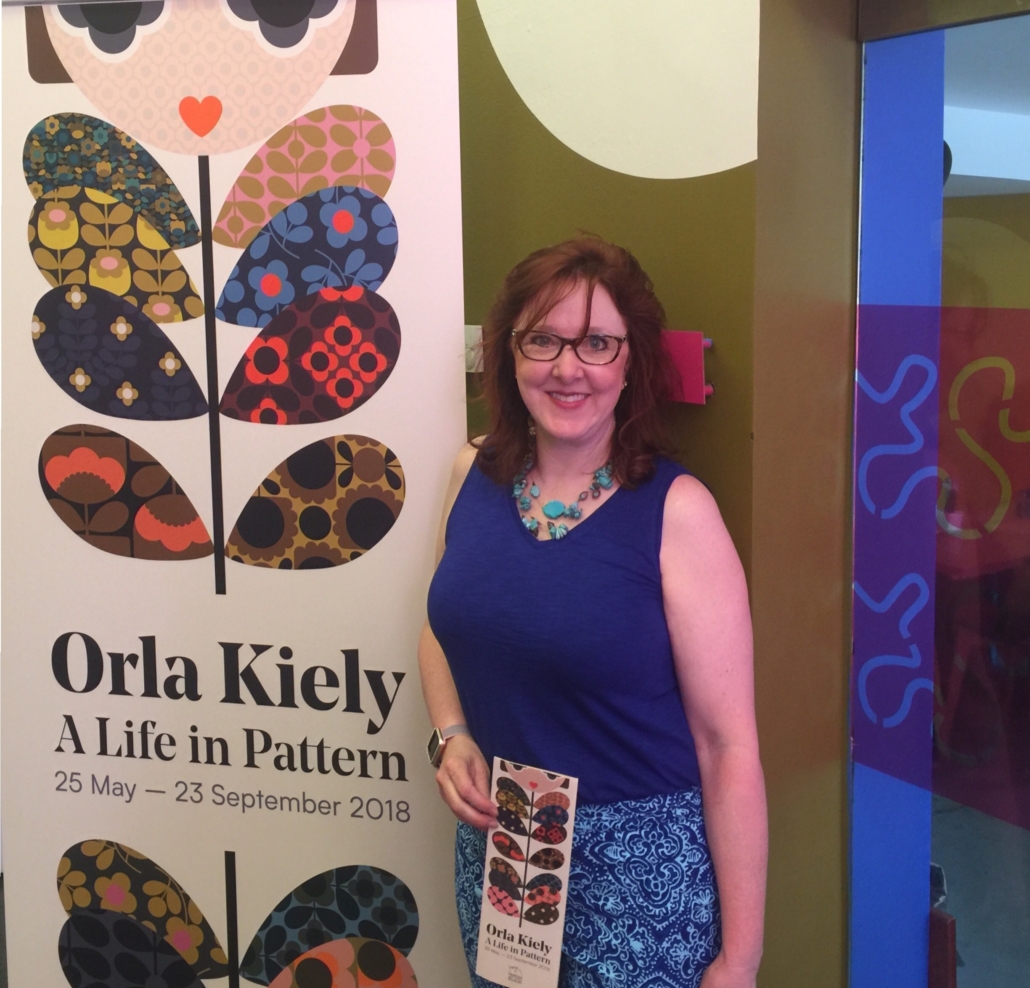
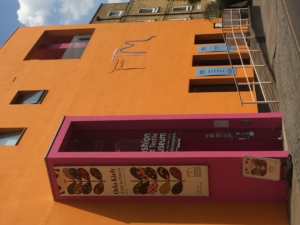 The last time I visited London, I found this wonderful little gem of a museum in the Southwark neighborhood. This visit, they are featuring the work of Orla Kiely, one of Ireland and the UK’s most famous fashion designers, a perfect blend after just completing my trip to Ireland!
The last time I visited London, I found this wonderful little gem of a museum in the Southwark neighborhood. This visit, they are featuring the work of Orla Kiely, one of Ireland and the UK’s most famous fashion designers, a perfect blend after just completing my trip to Ireland!
Orla Kiely studied textile design in Dublin in the early 1980’s and received her MA from the Royal College of Art in 1992. Having grown up in Ireland in the 60’s and 70’s, Orla’s design are influenced by the styles, colors and patterns of that era.

Designs from Orla’s college years
Nature inspires many of Kiely’s repeating patterns. Her “Stem” pattern has become an iconic design, catapulting Kiely into International design success in 2000.
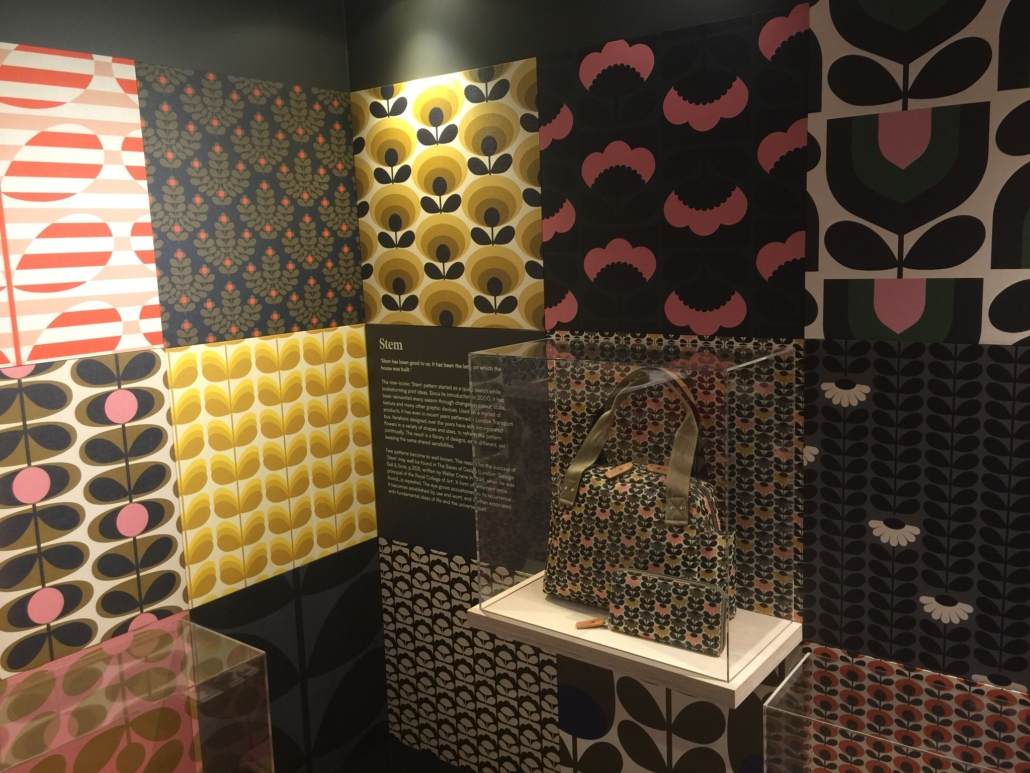
Display of different iterations of Orla Kiely’s Stem pattern.
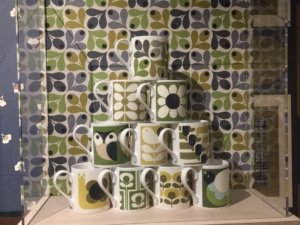
Coffee mug collection featuring Orla’s designs.
Her designs are based in rhythmic and repetitive pattern, now popular in accessories, handbags, wallpaper, and home decor, as well as her seasonal fashion collections.
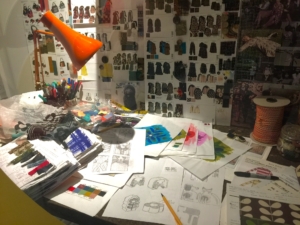
From the desk of Orla Kiely
Changes of scale, coordinating colors (often in a 1970’s palette, including avocado green, harvest gold, orange and chocolate brown), and whimsical, near-abstract depictions of animals are all common elements that make Orla’s designs unique and distinguishable. The exhibition includes over 150 patterns and products and is well worth attending!
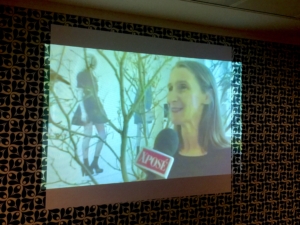
Filmed videos of Orla describing her inspirations, creative process, and collections, as well as footage of her fashion collection engage the audience in a multi media experience.
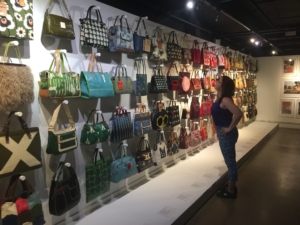
Christina surveying a display of Orla Kiely handbags
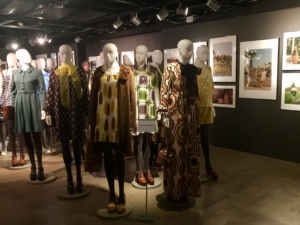
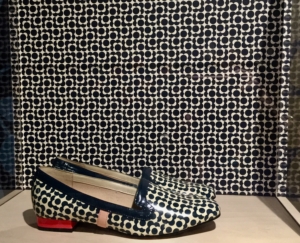
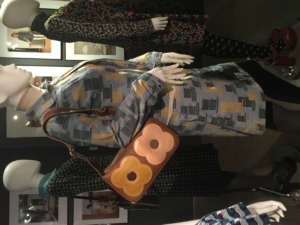

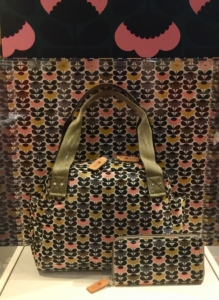
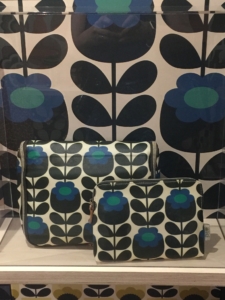

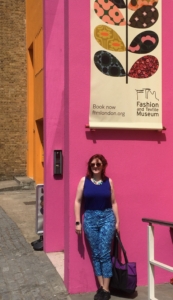
Day 4 – Game of Thrones Tapestry at the Ulster Museum, Belfast
My guilty pleasure… Game of Thrones (well, Fantasy & Science Fiction overall.) Now, mix that with textile art and I’m in heaven!
Before the final episodes of Game of Thrones were filmed, an army of designers, weavers and embroiderers in Northern Ireland was hard at work.
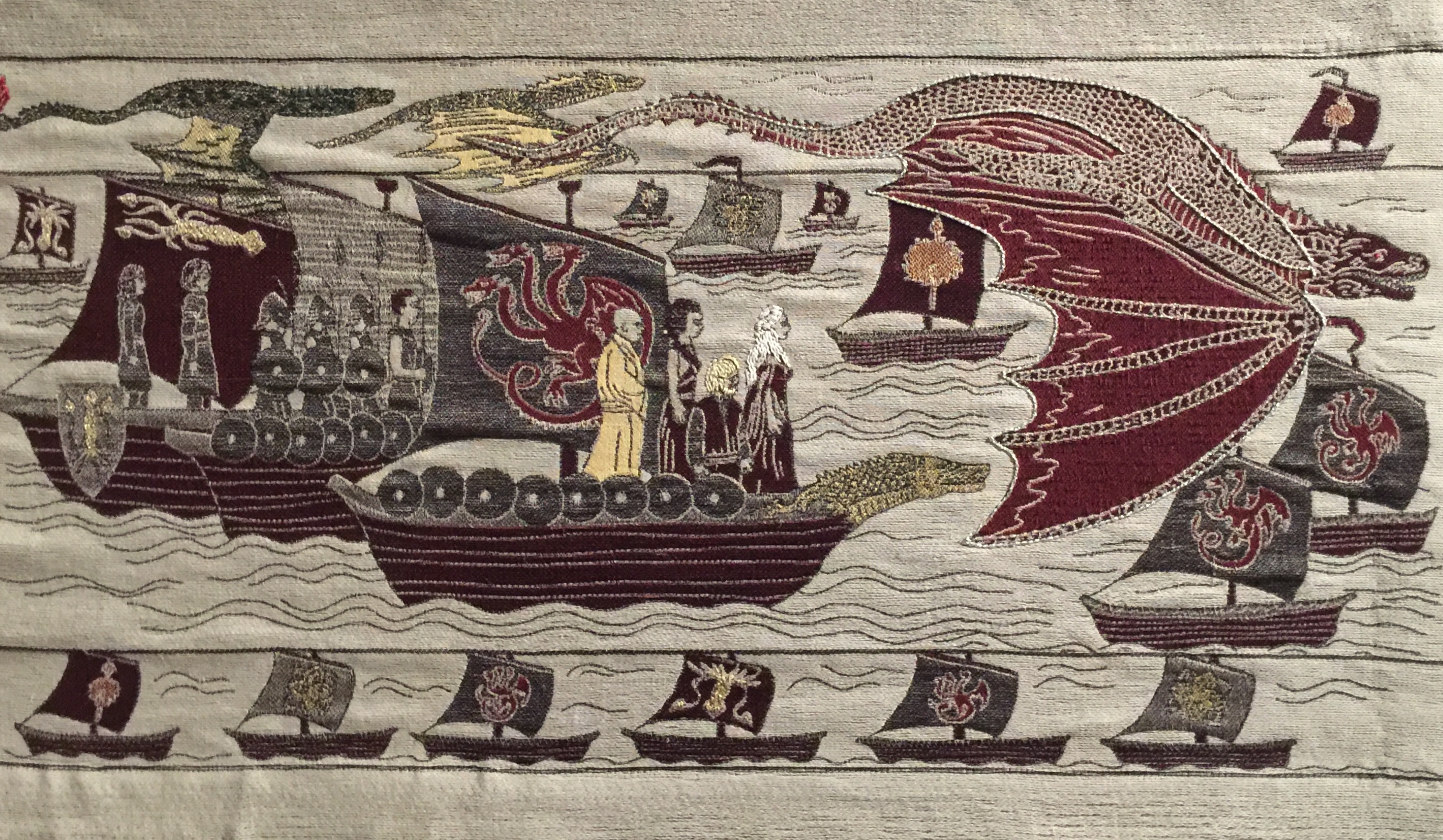 The tapestry was designed by hand by illustrators and color artists Carim Nahaboo, Jacob Merrick-Wolf, and Rob House. The weavers, Juliet Bailey, Franki Brewer, and a team at Dash & Miller in Bristol used a state-of-the-art jacquard loom. The linen thread was provided by Thomas Ferguson Irish Linen in Banbridge, one of the last surviving mills in Northern Ireland, and contains over 250,000 threads placed by hand.
The tapestry was designed by hand by illustrators and color artists Carim Nahaboo, Jacob Merrick-Wolf, and Rob House. The weavers, Juliet Bailey, Franki Brewer, and a team at Dash & Miller in Bristol used a state-of-the-art jacquard loom. The linen thread was provided by Thomas Ferguson Irish Linen in Banbridge, one of the last surviving mills in Northern Ireland, and contains over 250,000 threads placed by hand.
Each episode through season 7 is represented in the 253 foot tapestry. Rather than wait for the final season to be released (Season 8, set to air in 2019), the tapestry develops its own conclusion.

Embroiderer’s working on the Game of Thrones tapestry
After the weaving was complete, delicate hand embroidery added by a team of 30 stitchers at the Ulster Museum adds color, glints of metalics, and detailing to enhance the tapestry. From King Joffrey’s golden crown to Daenerys’ shimmering white and silver hair, blood red weddings, emerald green wildfire, cold-blue White Walkers and jet black ravens, threads of metallic, cotton and silk yarns bring vibrancy and lustre to the story. The embroidered elements are quite simple overall, but bring much to the finished project. Stitches include chain stitch, split stitch, back stitch, running stitch, couching and seed stitch.

Willow dragons made by Bob Johnson, basket maker at the Ulster Folk & Transport Museum
In Belfast’s Ulster Museum where the Tapestry is currently on display, they also have two magnificent Willow dragons soaring above the three story atrium
Click on the video below to view the entire tapestry!

A woman & young girl embroidering linens in County Down early 1900’s.
As well as information about the making of the tapestry, the exhibition included further documentation on the history of the linen industry in Northern Ireland, supplementing what I’d learned in Lisburn.

Dragon Head detail

The process of making the tapestry is described in this video by Northern Ireland’s tourism department:
Day 3 – Part 2 – Lisburn Linen Museum & More
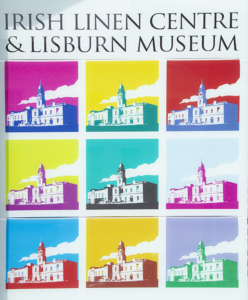 As many of you know, I have a wee bit ‘o Irish in my heritage. My paternal great-grandfather, Robert Fairley, emigrated from Lisburn in Northern Ireland around the turn of the century. I also have two g-g-grandparents from Ireland from different sides of my family tree. So between my familial name, red-headed genes from my Dad, and family lore, being Irish was the strongest ethnic identity stressed in my childhood.
As many of you know, I have a wee bit ‘o Irish in my heritage. My paternal great-grandfather, Robert Fairley, emigrated from Lisburn in Northern Ireland around the turn of the century. I also have two g-g-grandparents from Ireland from different sides of my family tree. So between my familial name, red-headed genes from my Dad, and family lore, being Irish was the strongest ethnic identity stressed in my childhood.
So I was very pleased to have found some possible distant cousins living outside of Lisburn prior to our trip! Unfortunately, many records in Ireland were destroyed in the Irish Civil War during a bombardment and resulting fire that ravaged the building in Dublin which housed Public Records, so we haven’t yet been able to trace the exact relationship. But, considering how few Fairley’s lived in the area, it’s quite likely we have ties a few generations back. We stopped in to meet these cousins in person and then went together to lunch and the Irish Linen Centre and Lisburn Museum.
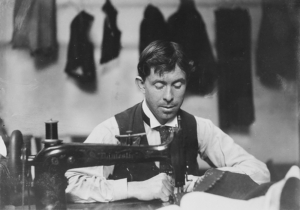
Robert McKee Fairley, my great-grandfather, at his tailoring shop in Salinas CA, c 1900.
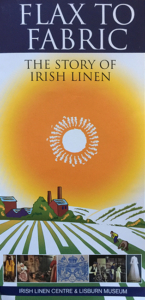
Lisburn, Northern Ireland – exhibition tracing the history of Irish Linen
The Museum’s researcher, Ciaran Toal, had kindly answered my inquiries about my family and met with me when we were there. The top floor of the museum is dedicated to their “Flax to Fabric – the Story of Irish Linen” exhibition. If you get a chance to go to Lisburn, a visit here is a must!
It starts with through the whole process of growing flax; hand harvesting & tying into parcels called”beets”; soaking the beets in water to soften the stems (a very pungent process); drying out the beets; and “Scrunching” by beating the flax stems with wooden clubs and then separating flax fibres from the unwanted woody parts of the stems. They have wonderful old photos of the each step of the process, as well as equipment used and samples.
After the flax production, the history of linen in the Lisburn area is displayed in depth, starting in 1698 when King William III appointed an Overseer of the Royal Linen Manufacture in Ireland and a weaving premises was set up in Lisburn. In the late 17th C, many immigrants from Northern England and Southern Scotland came to the Ulster region, probably including my Fairley ancestors.
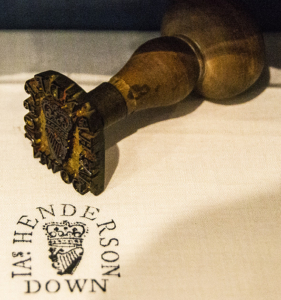
Linen seal stamped on linen to assure quality
The spinning of the flax into linen yarn or thread was mechanized in the 1820s, giving a fine quality yarn which was more reliable for weavers than hand-spun. When the linen cloth was taken from the loom, it was the original brown colour of the yarn. This was sold in “brown linen” markets. The process of bleaching brown linen yarn was complex and could last up to six months, but created a finer product. To create a lovely sheen on white linen, the bleached cloth went through a final process known as beetling, involving beating the cloth with mallets to close up the weave and achieve a dense, lustrous finish. Both brown and white linens had quality inspection processes where they had a seal used to verify the quality.
The stitching of the cloth, whether into garments or as embroidered embellishments, was the final step of the long process. While I’m not able to share any photos per agreement with the museum, I can tell you the needlework is nothing short of extraordinary! Veils of soft, semi-transparent linen gauze with incredibly fine perfect stitching; cutwork and drawn-thread work; Irish crochet lace; and much more.
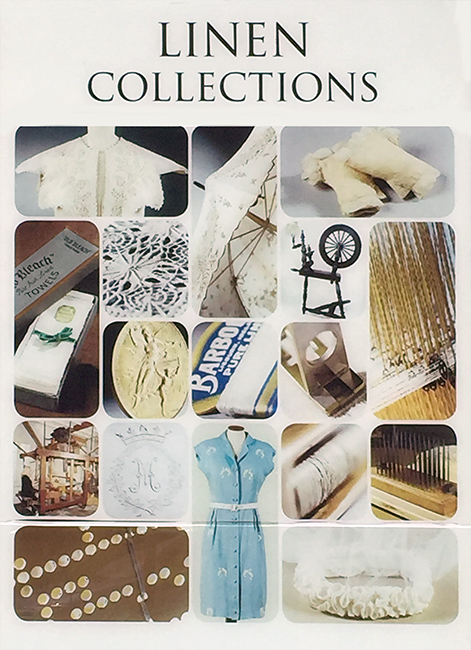 Some of the height of the collection includes pieces made for Queen Victoria, including a Golden Jubilee damask table doily from 1887 which was part of a set of 24 damask doilies depicting the new Royal Irish Linen Warehouse and a set of different miniature household items made for Queen Mary’s dollhouse! There was also information about Irish designer Sybil Connolly (1921-1998), who took inspiration from traditional Irish clothes and fabrics. Her clients included the Rockefellers, Mellons, Elizabeth Taylor, and Jacqueline Kennedy.
Some of the height of the collection includes pieces made for Queen Victoria, including a Golden Jubilee damask table doily from 1887 which was part of a set of 24 damask doilies depicting the new Royal Irish Linen Warehouse and a set of different miniature household items made for Queen Mary’s dollhouse! There was also information about Irish designer Sybil Connolly (1921-1998), who took inspiration from traditional Irish clothes and fabrics. Her clients included the Rockefellers, Mellons, Elizabeth Taylor, and Jacqueline Kennedy.
I could go on and on, but suspect I’ve probably written more than most would care to read. It was with some regret that I said good-bye to my newfound friends/cousins and to Lisburn. But, I suspect that I’ll be back sometime in the future!

Outside of the Irish Linen Centre and Lisburn Museum
Dublin Day 2, Part 2
While I’m no expert on couture fashion, the pieces displayed at the National Museum of Ireland- Decorative Arts’s Special exhibition of Ib Jorgensen’s fashion were clearly a cut above the ordinary. Born in Denmark, Jorgensen immigrated with his family to Ireland in 1950. He attended Dublin’s Grafton Academy of Dress Designing and first garnered attention when he won the Academy Cup is his graduating year fashion show in the tailored suits and coats division.

Hand embroidered and beaded silk jacket with evening skirt of green silk faille, 1989

Bead embroidery detail

Bead embroidery detail
Jorgensen’s work caught the eye of fashion hours, Nicolas O’Dwyer, who hired him as a designer and pattern cutter at only 20 years old. He was strongly influenced by the high standards of quality demanded by the workforce dervived from an old Jewish tailoring business.

Ib Jorgensen on the exhibition poster at the National Museum of Ireland- Decorative Arts, Dublin
High quality tailoring, superior pattern cutting, a relentless attention to detail and flawless finishing became the hallmarks of Jorgensen’s work.
The exhibition looks back at Ib’s long career, displaying a selection of some forty garments including day, cocktail and evening wear from across three and a half decades, supplemented with original fashion photography and illustrations. His first wife Patricia, a textile designer, created designs for extravagant hand beading, appliqué and embroidery, and these techniques were frequently used to great effect on Ib’s evening wear.

Hand beaded sequin shift dress in a harlequin design of soft pastel colors, 1967

Evening dress of orange silk voile with halter necked bodice entirely beaded and embroidered, 1985

Halter bodice detail

Beadwork embroidery detail.
For more information on this exhibition, go to the museum’s website at:
https://www.museum.ie/Decorative-Arts-History/Exhibitions/Current-Exhibitions/Ib-Jorgensen-–-A-Fashion-Retrospective


 2019
2019
